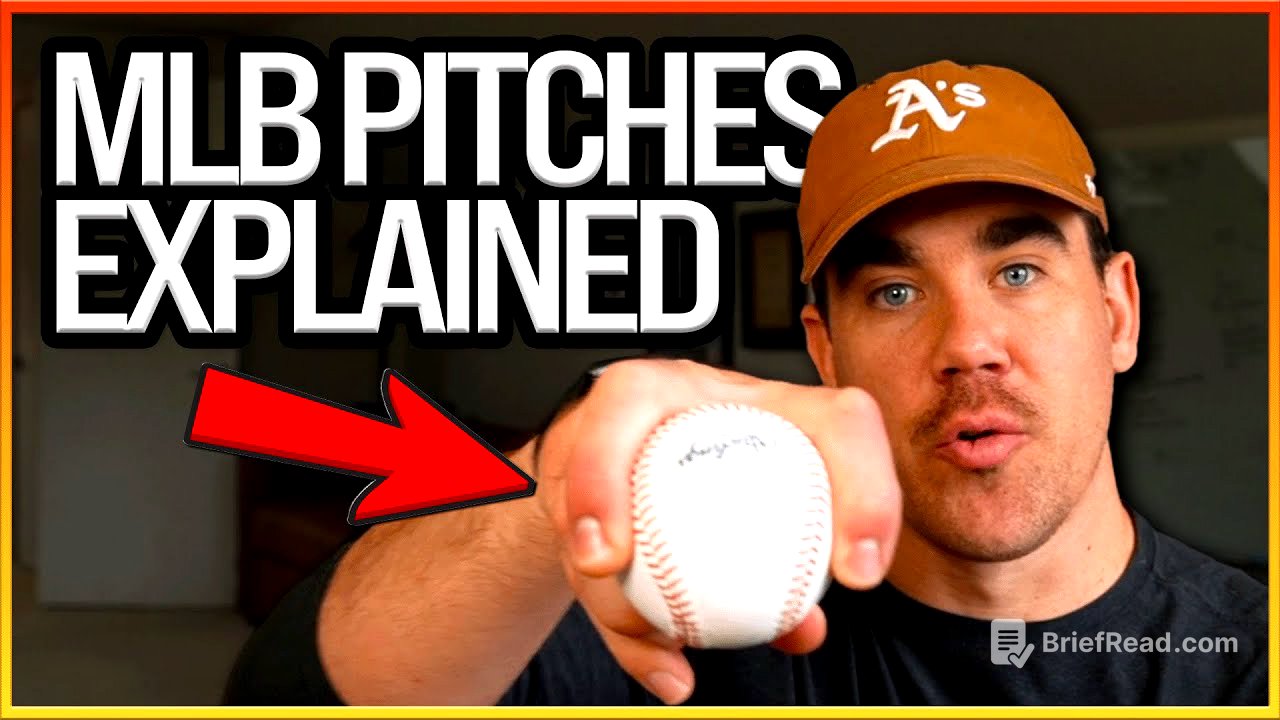TLDR;
This video serves as a comprehensive guide to understanding various baseball pitches, aimed at both newcomers and seasoned fans. Trevor May breaks down each pitch type, explaining the grip, movement, and purpose, while also providing examples of pitchers who excel at throwing them. The video covers fastballs, sliders, curveballs, off-speed pitches, and even some rare deliveries like the screwball and knuckleball.
- Explanation of key terms like "ride" and "drop" to describe pitch movement.
- Detailed breakdown of different fastball variations, including four-seam, sinker, two-seam, and cutter.
- Overview of slider types, such as traditional sliders (gyros) and sweepers.
- Discussion of curveball variations, including knuckle curves, 12-6 curves, and slurves.
- Explanation of various off-speed pitches like changeups, splitters, and forkballs.
Intro [0:00]
Trevor May introduces the video's purpose: to explain the different types of pitches in baseball for those who are new to the sport. Drawing on his 16 years of professional baseball experience, including 10 seasons in the major leagues, May aims to provide a primer on the various pitches seen on TV. He also encourages viewers to subscribe to his channel and check out his second channel, Moreday.
Things you should know [0:47]
Before diving into the pitch types, Trevor May explains four key terms to describe pitch movement: "up" (positive on the y-axis, referred to as ride), "down" (negative on the y-axis, referred to as drop), "right" (positive on the x-axis, arm side), and "left" (negative on the x-axis, glove side). Understanding these terms will help viewers follow baseball commentary and better understand the movement of different pitches. He emphasizes that while "arm side" and "glove side" switch based on the pitcher's handedness, it becomes intuitive with practice.
Fastballs [1:39]
Trevor May begins with fastballs, starting with the four-seam fastball, gripped by crossing the horseshoe or seams. The goal is to maximize velocity and vertical movement (ride), typically located at the top of the strike zone to induce pop-ups or swings and misses. Ride refers to the pitch defying gravity longer than usual, disrupting hitters' timing. Examples of pitchers with high vertical movement fastballs include Alex Vesia, Jonah Tong, and Jeremiah Estrada. Next is the sinker, gripped in various ways to achieve low vertical and high horizontal movement. The objective is to get hitters to swing on top of the ball, resulting in ground balls or weak contact. Zack Britton and Christopher Sanchez are noted for their elite sinkers. Two-seam fastballs prioritize velocity and arm side fade with less drop, often used against same-handed hitters to move the ball inside. Orion Kerkering and Joe Ryan are examples of pitchers with good two-seam fastballs. Finally, the cutter is gripped similarly to a four-seam fastball but with adjustments, prioritizing velocity, high horizontal movement, and high vertical movement. Zach Wheeler and Mariano Rivera are mentioned as prominent cutter users.
Sliders [4:30]
The slider category begins with the traditional slider, also known as the gyro, which involves a two-plane breaking ball that values both horizontal and vertical movement. Velocity remains a key factor. Mason Miller, Eric Scooble, and Brad Lidge are examples of pitchers who throw this type of slider. The sweeper is a breaking ball that prioritizes glove-side horizontal movement over velocity. The goal is to achieve Frisbee-like movement, defying gravity and moving significantly to one side. While velocity is beneficial, it is not essential, as slower speeds allow for more movement. Adam Ottavino is considered an originator of the sweeper, with Griffin Jax and Michael King being current examples.
Curveballs [6:06]
Trevor May transitions to curveballs, starting with the knuckle curve and the 12-6 curveball, which he groups together due to their similarities. The knuckle curve is named for its grip, often spiked or with a knuckle placed on the ball, while the 12-6 curveball is named for its movement from the top to the bottom of the clock, similar to a sweeper but in the vertical plane. Velocity is less critical for these pitches, with Max Fried (slower), Brendan Little (harder), and Hunter Brown (in between) as examples. All of them maximize drop. The slerve is a hybrid pitch between a knuckle curve and a slider, thrown intentionally by Seth Lugo. Lastly, the churve, thrown exclusively by Joey Lucchesi, involves a circle change grip turned over like a football.
Off-Speed (Changeups & similar) [7:48]
Moving on to off-speed pitches, Trevor May starts with the straight changeup, typically denoted by a circle grip, aimed at reducing velocity to create a significant speed difference from the fastball. However, it is becoming less common due to its difficulty to master. Trevor Hoffman is a notable example. The power change has largely replaced the straight change, using a similar grip but with a different ball and seam orientation to create arm-side movement or fade. Velocity reduction is less emphasized, with the focus on horizontal movement. Robert Suarez and Paul Skenes are examples. The splitter involves placing the ball between the fingers, increasing velocity and reducing spin, resulting in a swing-and-miss pitch, especially effective for four-seam fastball pitchers. Trey Savage, Yoshinobu Yamamoto, and Reed Garrett are examples. The split change is a slower version of the splitter, prioritizing direct drop over velocity, with Bryce Miller and Jeremiah Estrada as examples. The splinker is a recent development, bridging the gap between a splitter and a sinker, held with the fingers closer together for increased velocity and sink. Paul Skenes and Yoan Duran are known for throwing it. The forkball, a deeper variation of the splitter involving the knuckles, aims for minimal spin and maximum vertical drop. Kodai Senga, Roki Sasaki, and Jack Morris are examples.
Screwball [10:48]
The screwball is an older pitch still used by a few pitchers. It involves an extreme pronation of the wrist, rolling off the hand to create a unique spin. Brett Honeywell and Devin Williams are current examples in the major leagues.
Kuckleball [11:14]
The knuckleball involves gripping the ball with the fingertips or knuckles, aiming for zero spin to create unpredictable movement. There is no single correct way to throw it, other than minimizing spin. Steven Wright, R.A. Dickey, Tim Wakefield and Phil Niekro are examples of knuckleball pitchers.
Conclusion [12:00]
Trevor May concludes by stating he tried to keep the explanation as basic as possible, acknowledging the depth of the subject. He invites viewers to request a more advanced version in the comments and asks them to share their favorite and least favorite pitch names. He encourages viewers to like, subscribe, and turn on notifications for future videos.









